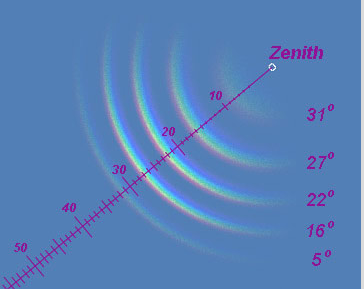CZA - Effect of solar altitude
CZA - Effect of Solar Altitude
Atmospheric optics is a fascinating field that explores the various optical phenomena occurring in our atmosphere. One such phenomenon is the Circumzenithal Arc (CZA), which forms under specific conditions when the sun is at a particular height in the sky. In this article, we will delve deeper into the CZA and examine how its appearance and characteristics change with varying solar altitudes.
The CZA is a beautiful, colorful arc that appears above the observer's head, parallel to the horizon. However, it can only be observed when the sun is less than 32.3° high. When the sun approaches this upper limit, the CZA becomes faint, diffuse, and positioned very close to the zenith, making it challenging to discern its distinct features.
As the sun descends further towards the horizon, the CZA becomes more pronounced and visually striking. It brightens, extending into an arc with an increasing radius and becoming narrower. The most optimal conditions for observing the CZA occur when the sun is approximately 22° high. At this solar altitude, the arc reaches its peak brilliance and exhibits its characteristic shape most prominently.
To better understand the effect of solar altitude on the CZA, let's explore some key points:
-
Arc Brightness: The brightness of the CZA intensifies as the sun's altitude decreases. When the sun is low on the horizon, the arc becomes more vivid and vibrant, making it a truly captivating sight to behold.
-
Arc Size: The size of the CZA changes with solar altitude. As the sun descends towards the horizon, the arc's radius increases, stretching across a wider portion of the sky. Conversely, when the sun is higher in the sky, the CZA appears smaller and more compact.
-
Arc Position: The position of the CZA relative to the observer also varies with solar altitude. When the sun is at its lowest point, the arc is positioned closer to the horizon, creating a larger angular distance from the zenith. As the sun rises higher, the CZA moves closer to the zenith, eventually reaching its closest proximity when the sun is around 32.3° high.
-
Arc Color: The CZA exhibits a beautiful array of colors, similar to a rainbow. These colors are caused by the scattering and refraction of sunlight through ice crystals in the atmosphere. The most prominent colors are usually red on the inner edge of the arc and blue on the outer edge.
-
Atmospheric Conditions: The appearance of the CZA can be influenced by various atmospheric conditions, such as the presence of ice crystals and the overall moisture content in the air. These factors can affect the clarity, brightness, and visibility of the arc, making each observation unique.
-
Photographic Opportunities: Due to its striking appearance and vibrant colors, the CZA presents an excellent opportunity for photographers to capture stunning images. Experimenting with different camera settings, angles, and compositions can result in truly mesmerizing photographs.
In conclusion, the Circumzenithal Arc (CZA) is a captivating atmospheric optical phenomenon that forms when the sun is below a specific altitude. As the solar altitude changes, so do the characteristics of the CZA, including its brightness, size, position, and color. Observing and photographing this beautiful arc can provide a unique and awe-inspiring experience for anyone interested in the wonders of atmospheric optics.

Arcs at different sun heights. Altitudes of the sun are on the right. The scale shows distances from the zenith.
The CZA forms only when sun is less than 32.3� high.
When the sun is near that upper limit the arc is faint, diffuse and very close to the zenith.
As the sun sinks the CZA brightens, extends into an arc of increasing radius and becomes narrower.
It is at its best when the sun is about 22� high.
Note: this article has been automatically converted from the old site and may not appear as intended. You can find the original article here.
Reference Atmospheric Optics
If you use any of the definitions, information, or data presented on Atmospheric Optics, please copy the link or reference below to properly credit us as the reference source. Thank you!
-
<a href="https://atoptics.co.uk/blog/cza-effect-of-solar-altitude/">CZA - Effect of solar altitude</a>
-
"CZA - Effect of solar altitude". Atmospheric Optics. Accessed on December 22, 2024. https://atoptics.co.uk/blog/cza-effect-of-solar-altitude/.
-
"CZA - Effect of solar altitude". Atmospheric Optics, https://atoptics.co.uk/blog/cza-effect-of-solar-altitude/. Accessed 22 December, 2024
-
CZA - Effect of solar altitude. Atmospheric Optics. Retrieved from https://atoptics.co.uk/blog/cza-effect-of-solar-altitude/.